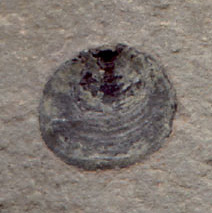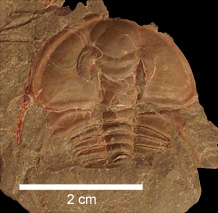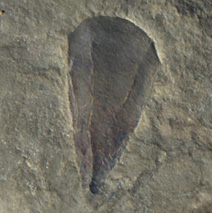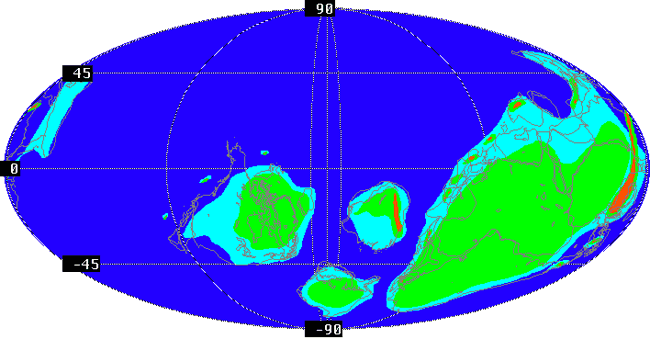What Important Event In Animal Evolution Marks The Beginning Of The Cambrian Period? Brainly
The Cambrian Period
The Cambrian Period marks an of import signal in the history of life on Earth; it is the time when about of the major groups of animals offset appear in the fossil record. This event is sometimes called the "Cambrian Explosion," because of the relatively short time over which this diversity of forms appears. It was once thought that Cambrian rocks independent the first and oldest fossil animals, but these are at present found in the earlier Ediacaran (Vendian) strata.
Life
About every metazoan phylum with difficult parts, and many that lack hard parts, fabricated its first advent in the Cambrian. The only mod phylum with an adequate fossil record to announced after the Cambrian was the phylum Bryozoa, which is not known before the early Ordovician. A few mineralized beast fossils, including sponge spicules and probable worm tubes, are known from the Ediacaran Period immediately preceding the Cambrian. Some of the odd fossils of the biota from the Ediacaran may likewise have been animals representative of living phyla, although this remains a somewhat controversial topic. However, the Cambrian was nonetheless a time of not bad evolutionary innovation, with many major groups of organisms actualization inside a bridge of only twoscore 1000000 years. Trace fossils fabricated past animals also show increased diversity in Cambrian rocks, showing that the animals of the Cambrian were developing new ecological niches and strategies — such as active hunting, burrowing deeply into sediment, and making complex branching burrows. Finally, the Cambrian saw the advent and/or diversification of mineralized algae of various types, such as the coralline red algae and the dasyclad green algae.
This does non mean that life in the Cambrian seas would have been perfectly familiar to a modern-twenty-four hours SCUBA diver! Although near all of the living marine phyla were nowadays, most were represented by classes that accept since gone extinct or faded in importance. For example, the Brachiopoda was present, but greatest diverseness was shown by inarticulate brachiopods (like the one pictured below, left). The articulate brachiopods, which would boss the marine environment in the later Paleozoic, were still relatively rare and not especially diverse. Cambrian echinoderms were predominantly unfamiliar and strange-looking types such as early edrioasteroids, eocrinoids, and helicoplacoids. The more than familiar starfish, breakable stars, and sea urchins had non yet evolved, and there is some controversy over whether crinoids (body of water lilies) were nowadays or not. Fifty-fifty if present, crinoids were rare in the Cambrian, although they became numerous and various through the later Paleozoic. And while jawless vertebrates were present in the Cambrian, it was not until the Ordovician that armored fish became common enough to exit a rich fossil record.
 | |  | |  |
| Left: Acrothele, a fairly common inarticulate brachiopod from the the Wheeler Shale of western Utah. Middle: Olenellus fremontii from the Latham Shale of southern California. Right: A hyolith, also from the Latham Shale. | ||||
Other dominant Cambrian invertebrates with hard parts were trilobites (similar the 1 pictured to a higher place), archaeocyathids (relatives of sponges that were restricted to the Lower Cambrian), and problematic conical fossils known as hyolithids (like the i pictured in a higher place, right). Many Early Cambrian invertebrates are known just from "pocket-size shelly fossils" — tiny plates, scales, spines, tubes, and then on. Many of these were probably pieces of the skeletons of larger animals.
A few localities effectually the world that preserve soft-bodied fossils of the Cambrian prove that the "Cambrian radiation" generated many unusual forms not hands comparable with anything today. The best-known of these sites is the legendary Burgess Shale (centre Cambrian) in the British Columbian Rocky Mountains. Sites in Utah, southern Communist china, Siberia, and n Greenland are also noted for their unusually good preservation of not-mineralized fossils from the Cambrian. One of these "weird wonders", first documented from the Burgess Shale, is Wiwaxia, depicted at lower left. Wiwaxia was an inch-long, creeping, scaly and spiny bottom dweller that may take been a relative of the molluscs, the annelids, or possibly an extinct animal grouping that combined features of both phyla.
Stratigraphy
A lot tin can happen in forty million years, the approximate length of the Cambrian Period. Animals showed dramatic diversification during this catamenia of Globe'due south history. This has been called the "Cambrian Explosion". When the fossil tape is scrutinized closely, it turns out that the fastest growth in the number of major new animal groups took place during the as-yet-unnamed second and third stages (more often than not known as the Tommotian and Atdabanian stages) of the early Cambrian, a period of most 13 1000000 years. In that time, the first undoubted fossil annelids, arthropods, brachiopods, echinoderms, molluscs, onychophorans, poriferans, and priapulids show upwardly in rocks all over the world.
Stratigraphic boundaries are generally adamant by the occurences of fossils. For case, the trace fossil Treptichnus pedum marks the base of operations of the Cambrian. This boundary is an unusual case, since stratigraphic boundaries are normally defined by the presence or absence of groups of fossils, called assemblages. In fact, much paleontological work is concerned with questions surrounding when and where stratigraphic boundaries should be defined. At beginning glance, this may not seem like important work, but consider this: if you wanted to know near the evolution of life on Earth, you would demand a fairly accurate timeline. Questions such as: "how long did something stay the aforementioned?" or,"how fast did it alter?" tin can but be assessed in the context of fourth dimension.
Tectonics and paleoclimate
The Cambrian follows the Ediacaran Period, during which time the continents had been joined in a single supercontinent called Rodinia (from the Russian word for "homeland", rodina). As the Cambrian began, Rodinia began to fragment into smaller continents, which did non always represent to the ones we see today. The reconstruction below shows the rifting of Rodinia during the second phase (Tommotian) of the Cambrian . Green represents land in a higher place water at this fourth dimension, ruby indicates mountains, calorie-free bluish indicates shallow seas of the continental shelves, and dark blue denotes the deep ocean basins. (For clarity, the outlines of present-day continents take been superimposed on the map.)

Earth climates were mild; in that location was no glaciation. Landmasses were scattered every bit a result of the fragmentation of the supercontinent Rodinia that had existed in the late Proterozoic. Well-nigh of Due north America lay in warm southern tropical and temperate latitudes, which supported the growth of all-encompassing shallow-h2o archaeocyathid reefs all through the early Cambrian. Siberia, which also supported arable reefs, was a separate continent due east of North America. Baltica — what is now Scandinavia, eastern Europe, and European Russia — lay to the s. Well-nigh of the rest of the continents were joined together in the supercontinent Gondwana, depicted on the right side of the map; South America, Africa, Antarctica, India, and Australia are all visible. What is now Prc and east Asia was fragmented at the time, with the fragments visible north and west of Australia. Western Europe was besides in pieces, with most of them lying northwest of what is now the north African coastline. The nowadays-mean solar day southeastern United States are visible wedged between South America and Africa; they did not become part of North America for another 300 million years. Tectonism afflicted regions of Gondwana, primarily in what are now Commonwealth of australia, Antarctica, and Argentine republic. The continental plate movement and collisions during this period generated pressure and estrus, resulting in the folding, faulting, and crumpling of rock and the formation of large mountain ranges.
The Cambrian globe was bracketed between two ice ages, one during the late Proterozoic and the other during the Ordovician. During these water ice ages, the decrease in global temperature led to mass extinctions. Libation weather eliminated many warm h2o species, and glaciation lowered global ocean level. However, during the Cambrian there was no meaning ice germination. None of the continents were located at the poles so land temperatures remained mild. In fact, global climate was probably warmer and more uniform than it is today. With the retreat of Proterozoic ice, the sea level rose significantly. Lowland areas such as Baltica were flooded and much of the world was covered past epeiric seas. This event opened up new habitats where marine invertebrates, such equally trilobites, radiated and flourished.
Plants had not yet evolved, and the terrestrial globe was devoid of vegetation and inhospitable to life equally we know information technology. Photosynthesis and primary production were the monopoly of bacteria and algal protists that populated the world's shallow seas.
Likewise during the Cambrian, the oceans became oxygenated. Although in that location was plentiful atmospheric oxygen by the showtime of the period, it wasn't until the Cambrian that there was a sufficient reduction in the number of oxygen-depleting leaner to permit higher oxygen levels in the waters. This dissolved oxygen may have triggered the "Cambrian Explosion" — when about of the major groups of animals, specially those with hard shells, first appeared in the fossil tape.
Localities
-
Aldan River, Siberia,: This early on Cambrian fauna tells u.s.a. about the early on development of animals with skeletons.
-
Burgess Shale, British Columbia: Thousands of soft-bodied animal fossils pigment united states a moving picture of early on marine life.
-
House Range, Utah: An array of Cambrian critters has been found in the Wheeler Shale and the Marjum Formation.
-
Marble Mountains, California: Olenellid trilobites and more are found in this Mojave Desert locality.
-
White-Inyo Mountains, California: Visit aboriginal Cambrian reefs in these mountains of eastern California.
Resources
- Find out more virtually the Cambrian paleontology and geology of N America at the Paleontology Portal.
- Run into the Wikipedia page on the Cambrian.
Source: https://ucmp.berkeley.edu/cambrian/cambrian.php
Posted by: clelandithey1963.blogspot.com

0 Response to "What Important Event In Animal Evolution Marks The Beginning Of The Cambrian Period? Brainly"
Post a Comment